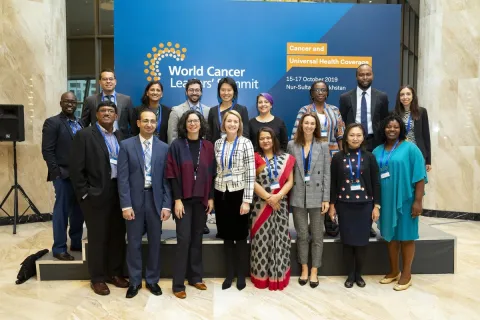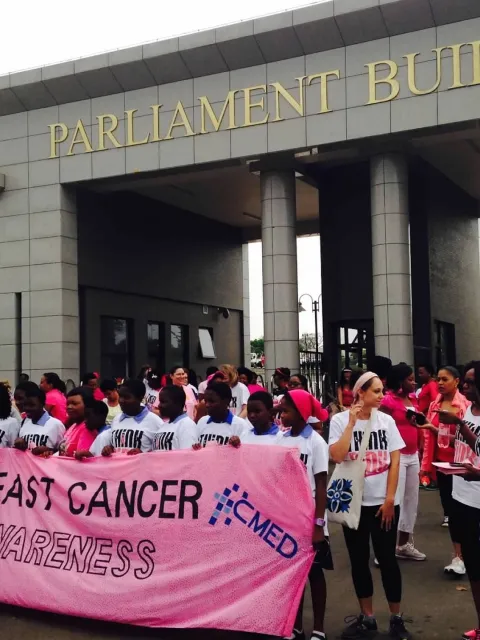Investing in cancer control to save lives
Dr Felipe Roitberg, Cancer Management Control Consultant at WHO and UICC Young Leader, speaks about how countries can assess their needs and optimise their investment in cancer control.

The UICC Young Leaders’ programme offers recognition and visibility to young cancer control professionals. It provides them with a network of peers, opportunities for connecting with experienced leaders and to play an active role at international events. They are invited to attend the World Cancer Leaders’ Summit (being held this October in Boston, with virtual participation from around the world), enabled to engage in a project aligned with UICC’s thematic areas of work or have a visit funded to a cancer organisation to develop skills and increase collaboration within the cancer community.
As a new call for the 2021/2022 cohort of Young Leaders opened on 26th March, UICC speaks with a member of the 2019/2020 cohort, Dr Felipe Roitberg, who has been engaged this past year in studying the impact of COVID-19 on cancer care.
Dr Felipe Roitberg, Cancer Management Control Consultant at WHO, at the 2019 World Cancer Leaders Summit
Dr Roitberg was a practicising oncologist for 10 years in Brazil and now works as Cancer Management Control Consultant at the World Health Organization (WHO). In that capacity, he has contributed to two systemic reviews on “Delays and Disruptions in Cancer Health Care Due to COVID-19 Pandemic” and “Impact of Strategies for Mitigating Delays and Disruptions in Cancer Care Due to COVID-19”.
Notably, Dr Roitberg helped to develop an assessment costing tool, which enables countries to gain perspective on their current health system capacity, their needs in terms of quality and coverage of service provision, and what may be optimal cost-effective interventions to address gaps in cancer care.
Can you give an overview of your work at WHO as Cancer Control Management Consultant in the Non-Communicable Diseases (NCDs) team?
Often a consultant is designated to a specific task but, in my role, I have been deeply involved with the activities regarding National Cancer Control (NCCP) analysis and implementation. This ultimately addresses the WHO Global Cancer initiatives and the cross-cutting initiatives involving health workforce, access to medicines, aligned with the impact and cost analysis related to cancer care interventions. All those activities are coordinated under André Ilbawi's guidance and leadership, the WHO Technical Officer for cancer – and also a UICC Young Leader alumni.
Just over a year after the outbreak of the coronavirus pandemic, what assessment do you make of the state of disruptions to cancer care and the possible long-term impact on cancer incidence and mortality?
The two systemic reviews that we conducted on the impact of COVID-19 are connected, in the sense that proper data on the delays and disruptions provide evidence-based information to allow Member States to effectively map where the problem is and its magnitude, and to support the implementation of tailored mitigation strategies.
What we learned in the first review was that delays and disruptions had broadly three main drivers: COVID-19 context-related, such as lockdowns and restrictions on travel or social gatherings aimed at containing the spread of the virus; health system-related or provider-related, for instance hospitals and physicians asking patients to stay away, or the suspension of treatment or other services; and patient-related, where care centres may be open and it is possible to travel there, but the patient decides to stay away out of fear of contagion or because of financial constraints due to the economic consequences of the pandemic.
Health system-related disruptions were the most frequent, and these concerned delays in surgeries and radiotherapy as well as the rescheduling or cancellation of outpatient visits. These disruptions affected not only service delivery at care facilities, but also medical supplies and workforce availability.
The important takeaway for us was that, while most of the disruptions came from strategies aimed at protecting public health and patients, the unintended consequence was an additional burden on cancer care that also potentially puts the health of patients at risk. Now it is time to refine the decision-making trade-offs and implement the necessary tailored mitigation strategies.
And what are some of the possible mitigation strategies? What investments should governments make to flatten the curve of a future possible increase in cancer-related deaths due to late diagnosis or delayed treatments?
Our group reviewed nearly 6,600 references. However, only nine studies were included as offering mitigation strategies linked to measurable patient or health system outcomes. In other words, they provided key information to measure and monitor the impact that a given intervention will possibly return as a health benefit from a public health perspective. Ultimately, when the outcome of a mitigation strategy is measured, health economic specialists are able to model the impact of such interventions to reduce the burden of COVID-19 on cancer care and effectively provide evidence basis to support their implementation.
Therefore, considering the consequences of COVID-19 in terms of disruptions to health systems, we also aimed to improve the capacity to analyse the impact on cancer care. Thus, the cited systematic review served as evidence to map the nature of the disruptions and the degree to which they affect service delivery. Subsequently, we built up a model on the top of an WHO assessment-costing tool, so we are now able to project the impact of COVID-19 based on several factors in terms of mortality and how mitigation strategies that reduce such delays and disruptions might save lives.
A reduction in the coverage and/or quality of cancer services and the duration of the outbreak are factors that can directly affect outcomes for patients, in terms of when or at what stage the cancer is diagnosed relative to what it might have been without the disruption, as well as on mortality. Overall, the tool allows us to plot in time until 2030 how improving each variable related to cancer patient outcomes might save lives. The narrative is, therefore, not how many lives we are losing but how many lives we are saving when addressing the disruptions, implementing mitigation strategies and investing in the most effective interventions.
You mentioned an assessment costing tool, which you developed with Dr Ilbawi to enable countries to determine what would be the most efficient measures for their particular situation. How does work in practice?
The costing or priority setting tool is based on the WHO OneHealth tool, which addresses the costs and health benefits of health interventions. It is a value-for-money strategy that looks comprehensively at the entire cancer continuum.
WHO and IARC conducted an extensive mapping of countries’ cancer profiles and current capacities of their health systems. Such a model aims to support governments in three areas of their cancer control planning and implementation: assist in prioritising cancer control programmes; identify key interventions with a universal health coverage benefit package proposal; and generate an investment plan that fully supports the implementation of national cancer control plans and is in accordance with the WHO mandate.
While there are more than 150 listed interventions with measurable outcomes for 14 reference cancers, the interventions can be selected according to three levels of benefits packages depending on the status of a country’s health system and its finances.
Such a comprehensive analysis intends to frame public dialogue and inform the decision-making process, so countries are able to mobilise funds, prioritise interventions adoption, scale up effective services and make the most efficient purchases, whether this means investing in skilled workforce, ensuring the supply of medicines, acquiring the necessary equipment or purchasing the most needed essential medicines according to their cancer policies.
Ultimately, the tool is designed to enable countries to better measure and compare the trade-offs between interventions and required investment before making decisions, in order to obtain the highest value-for-money health benefit.
Can you tell us a bit more about your experience with the UICC Young Leaders’ programme and how it has influenced your current work?
I met Dr André Ilbawi, a former UICC Young Leader himself, three years ago in Madrid at the European Society for Medical Oncology conference. He was talking about national cancer control plans and was fascinated with this aspect of public health: only 10% of NCCPs address costing, but how can you effectively implement an NCCP if the plan does not consider the investments associated with the planned interventions and what the trade-offs might be? So I approached him afterwards and asked how I could contribute and support his work. He encouraged me to apply for the UICC Young Leaders programme, which I had both the honour, and privilege to join.
This encounter shows how well integrated and connected people working in global policy for cancer care are. It also reflects how much those in the Young Leaders programme can be an inspiration to others, talking compellingly on practical advances in cancer control, and exchanging extremely useful practical knowledge in the field. I hope to similarly encourage new UICC young leaders to join this programme and support them as my peers did with me.
This dedication feeds into the work we do at WHO, of course, as we aim to create value in serving Member States and the people in need. This is what makes our work worthwhile.
Learn more about the UICC Young Leaders programme
Young Leaders 2021-2022: Call for applications
Last update
Thursday 05 August 2021
